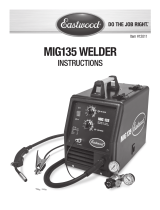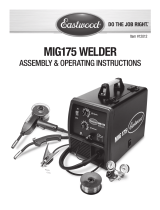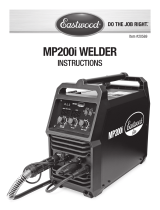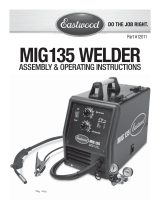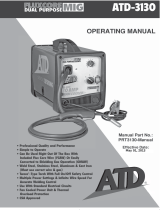Page is loading ...

PRO SERIES AUTO FEED MIG 130 WELDING WELDER 110/220V
SAVE THIS MANUAL: KEEP THIS MANUAL FOR SAFETY WARNINGS, PRECAUTIONS, ASSEMBLY,
OPERATING, INSPECTION, MAINTENANCE AND CLEANING PROCEDURES. WRITE THE PRODUCT’S
SERIAL NUMBER ON THE BACK OF THE MANUAL NEAR THE ASSEMBLY DIAGRAM (OR MONTH
AND YEAR OF PURCHASE IF PRODUCT HAS NO NUMBER).
OWNER’S MANUAL AND SAFETY INSTRUCTIONS
ITEM: 55019
FOR QUESTIONS PLEASE CALL OUR CUSTOMER SUPPORT: (909) 628 4900 MON-FRI 9AM TO 3PM PST

IMPORTANT SAFETY INFORMATION
GENERAL SAFETY WARNINGS
Read all safety warnings and instructions. Failure to follow the warnings and instructions
may result in electric shock, re and/or serious injury. Save all warnings and instructions
for future reference.
SAFETY
The warnings, precautions, and instructions discussed in this instruction manual cannot cover
all possible conditions and situations that may occur. It must be understood by the operator that
common sense and caution are factors which cannot be built into this product, but must be supplied
by the operator. Read carefully and understand all ASSEMBLY AND OPERATION INSTRUCTIONS
before operating. Failure to follow the safety rules and other basic safety precautions may result in
serious personal injury.
Stay alert, watch what you are doing, and use common sense when operating the tool. DO NOT use the
tool while you are tired or under the inuence of drugs, alcohol, or medication.
Wear the proper personal protective equipment when necessary. Use ANSI Z87.1 compliant safety
goggles (not safety glasses) with side shields. Leather leggings, re resistant shoes or boots should be
worn when using this product This applies to all persons in the work area. Keep clothing free of grease,
oil, solvents, or any ammable substances Wear dry, insulating gloves and protective clothing.
1
Read and understand all instructions. Failure to follow all instructions may result in serious injury
or property damage.
DO NOT allow persons to operate or assemble the product until they have read this manual and
have developed a thorough understanding of how it works.
DO NOT modify this product in any way. Unauthorized modication may impair the function and/or
safety and could affect the life of the product. There are specic applications for which the product
was designed.
Use the right tool for the job. DO NOT attempt to force small equipment to do the work of larger
industrial equipment. There are certain applications for which this equipment was designed. This
product will be safer and do a better job at the capacity for which it was intended. DO NOT use
this equipment for a purpose for which it was not intended.
Inspect the work area before each use. Keep work area clean, dry, free of clutter, and well-lit.
Cluttered, wet, or dark work areas can result in injury.
Keep children and bystanders away from the work area while operating this product. DO NOT
allow children to handle the product.
Check for damaged parts before each use. Carefully check that the product will operate properly and
perform its intended function. Replace damaged or worn parts immediately. Never operate the
product with a damaged part.
DO NOT use near degreasing or painting operations.

IMPORTANT SAFETY INFORMATION
2
INHALATION HAZARD: Exposure to welding or cutting exhaust fumes can increase the risk of
developing certain cancers, such as cancer of the larynx and lung cancer. Also, some diseases that may
be linked to exposure to welding or cutting exhaust fumes are: Early onset of Parkinson’s Disease • Heart
disease • Ulcers • Damage to the reproductive organs • Inammation of the small intestine or stomach
• Kidney damage • Respiratory diseases such as emphysema, bronchitis, or pneumonia. Use natural or
forced air ventilation and wear a respirator approved by NIOSH to protect against the fumes produced to
reduce the risk of developing the above illnesses.
Keep head out of fumes. DO NOT breathe exhaust fumes
Use enough ventilation, exhaust at arc, or both, to keep fumes and gases from breathing zone and
general area. If engineering controls are not feasible, use an approved respirator.
Work in a conned area only if it is well-ventilated, or while wearing an air-supplied respirator
Have a recognized specialist in industrial Hygiene or Environmental Services check the operation
and air quality and make recommendations for the specic welding situation. Follow OSHA guidelines
for Permissible Exposure Limits (PEL’s) and the American Conference of Governmental Industrial
Hygienists recommendations for Threshold Limit Values (TLV’s) for fumes and gases.
Turn off, disconnect power, and discharge electrode to ground before setting down torch/electrode
holder and before service.
DO NOT touch energized electrical parts. Wear dry, insulating gloves. DO NOT touch electrode holder,
electrode, welding torch, or welding wire with bare hand. DO NOT wear wet or damaged gloves.
Connect to grounded, GFCI-protected power supply only.
People with pacemakers should consult their physician(s) before use. Electromagnetic elds in close
proximity to heart pacemaker could cause pacemaker interference or pacemaker failure.
DO NOT expose welders to rain or wet conditions. Water entering a welder will increase the risk of
electric shock.
DO NOT abuse the cord. Never use the cord for carrying, pulling or unplugging the welder. Keep cord
away from heat, oil, sharp edges or moving parts. Damaged or entangled cords increase the risk of
electric shock.
DO NOT use indoors.
Insulate yourself from the work piece and ground. Use non-ammable, dry insulating material if possible,
or use dry rubber mats, dry wood or plywood, or other dry insulating material large enough to cover your
full area of contact with the work or ground.
Clear away or protect ammable objects. Remove or make safe all combustible materials for a radius
of 35 feet (10 meters) around the work area. Use a re resistant material to cover or block all open
doorways, windows, cracks, and other openings.
ALWAYS keep a re extinguisher nearby whenever operating the machine.
DO NOT operate welders in atmospheres containing dangerously reactive or ammable liquids, gases,
vapors, or dust. Provide adequate ventilation in work areas to prevent accumulation of such substances.
Welders create sparks which may ignite ammable substances or make reactive fumes toxic.
If working on a metal wall, ceiling, etc., prevent ignition of combustibles on the other side by moving the
combustibles to a safe location.

DO NOT weld or cut on materials having a combustible coating or combustible internal structure, as in
walls or ceilings, without an approved method for eliminating the hazard.
IMPORTANT SAFETY INFORMATION
DO NOT dispose of hot slag in containers holding combustible materials.
After welding, make a thorough examination for evidence of re. Be aware that easily visible smoke or
ame may not be present for some time after the re has started.
DO NOT apply heat to a container that has held an unknown substance or a combustible material whose
contents, when heated, can produce ammable or explosive vapors. Clean and purge containers before
applying heat. Vent closed containers, including castings, before preheating, welding, or cutting.
DO NOT use the welder if the switch does not turn it on and off. Any welder that cannot be controlled
with the switch is dangerous and must be repaired.
Disconnect the plug from the power source before making any adjustments, changing accessories, or
storing welders. Such preventive safety measures reduce the risk of starting the welder accidentally.
Prevent unintentional starting. Ensure the switch is in the off position before connecting to power
source or moving the welder.
Store idle welders out of the reach of children and do not allow persons unfamiliar with the welder or
these instructions to operate the welder.
Use the welder and accessories in accordance with these instructions, taking into account the working
conditions and the work to be performed. Use of the welder for operations different from those intended
could result in serious injury or property damage.
DO NOT use the welder for pipe thawing.
Maintain welders. Check for misalignment or binding of moving parts, breakage of parts and any other
condition that may affect the welder’s operation. If damaged, have the welder repaired before use.
Have your welder serviced by a qualied repair person using only identical replacement parts.
Maintain labels and nameplates on the Welder. These carry important information. If unreadable or
missing, contact Stark Tools for a replacement.
Unplug before maintenance. Unplug the Welder from its electrical outlet before any inspection,
maintenance, or cleaning procedures.
NEVER weld on a pressurized or a closed cylinder.
NEVER allow an electrode holder, electrode, welding torch, or welding wire to touch the cylinder.
Keep cylinders away from any electrical circuits, including welding circuits.
Keep protective cap in place over the valve except when the cylinder is in use.
Use only correct gas shielding equipment designed specically for the type of welding you will do.
Protect gas cylinders from heat, being struck, physical damage, slag, ames, sparks, and arcs.
ALWAYS use proper procedures to move cylinders.
3

DIAGRAMS AND SPECIFICATIONS
4
POWER
SWITCH
NEGATIVE
TERMINAL
VOLTAGE
KNOB
POSITIVE
TERMINAL
WORK
INDICATOR
SPOT
TIMER
MIG TORCH
SELECTOR
TORCH
GROUND
CABLE &
CLAMP
CHIPPING
HAMMER
W I R E
BRUSH
TENSION
WIRE
WELDING
MASK
Variable Feed Speed Control
Torch With Full On / Off Safety Control
Automatic Thermal Safety Protection
Adjustable 4-setting heating
Gas Less Welder
Torch With Full On / Off Safety Control
1X welder machine
1X welding gun
1X Welding Wire
1X welding mask
1X brush
SPECIFICATIONS
FEATURES

4
PARTS AND ACCESSORIES

5
PARTS AND ACCESSORIES
WARNING! TO PREVENT DEATH FROM APHYXIATION
DO NOT open gas without proper ventilation. Fix gas leaks
immediately. Shielding gas can displace air and cause rapid loss of
consciousness and death. Shielding gas without carbon dioxide
can be even more hazardous because asphyxiation can start
without feeling shortness of breath.

OPERATION
6
The Mig100 130 welder requires a dedicated 120 AC , 60 Hz power input. Please check carefully the
welder you have in hand is 120V before using. If using an extension cord, use a minimum 12 AWG cord for
up to 25 feet.
1. Open the top door of the welder.
CHANGING THE DRIVE ROLLER
The MIG100/130 comes set up and ready to use 0.035″ (0.9mm) Flux-Core Wire. If 0.03″ (0.8mm) wire is to
be used, the drive roller needs to be adjusted. Adjust the drive roller according to the following procedure:
2. Lift the Pressure Adjuster out of the way and move the Rocker Arm away from the drive roller.
3. Remove the Drive Roller Thumb Screw by turning it counter clockwise and pulling it away from the
roller.
4. Remove the Drive Roller and view the wire sizes stamped on each side of the roller.
5. Install the Drive Roller in the orientation so that the size of the wire you are using is facing you on
the side of the drive roller.
6. Reinstall the Drive Roller Thumb Screw.
7. Put the Rocker Arm back in place and reset the Pressure Adjuster.
The MIG100/130 could be used with a 4 inch wire spool only. To install the wire spool follow the procedure
listed below:
INSTALLING THE WIRE
1. Open the door of the welder and remove the wing nut and spacer from the Wire Spool Spindle.
2. Slide the 4 inch Wire Spool onto the Wire Spindle and reinstall the spacer and wing nut.
THREADING WELDING WIRE THROUGH THE DRIVE MOTOR TO THE WELDING GUN
This welder uses only self shielding ux-core wire in either 0.030″ or 0.035″ size (0.8 or 0.9mm). To install
the welding wire follow the procedure outlined below:
1. Turn the power switch to the off position and unplug the welder from the power supply.
2. Remove the contact tip and nozzle from the end of the torch.
3. Ensure that the drive roller is installed in the proper position for the wire size being used.
4. Unlock the Pressure Adjuster and lift up on the Rocker Arm. Ensure that the wire drive roller is appropriate
to the welding wire size see the previous section describing the installation of the drive roller. The drive
roller comes installed for 0.035″ (0.9mm) wire.
5. Pull out the welding wire from the wire spool carefully. NOTE: Do not let go of the wire or the entire spool
could unravel.
6. Cut off the small piece of the curved segment at the front of welding wire and straighten the welding wire
approximately 3.0″ long.
7. Thread the welding wire through the Guide Pipe and over the wire Drive Roller and into the torch hole.
8. Reattach the Rocker arm and reset the Pressure Adjuster.

OPERATION
7
9. Turn on the machine and set the wire speed.
10. With the gun pointed away from you and others, depress the trigger to begin feeding wire. NOTE: Watch
the drive roller to see if any slipping is occurring between the roller and wire, if so, turn the machine off and
tighten the Pressure Adjuster turn and test again.
11. Once the wire exits the end of the torch, install the contact tip and nozzle. Cut the wire about 1/4″ from
the end of the contact tip.
USAGE
Your MIG100/130 can be used to perform a large number of different types of welds, all of which will
require practice and testing before using on an actual project piece. This following welding process is just
a baseline to get you started.
1. Connect your ground clamp to the work pieces that are to be welded. Make sure the ground clamp
contacts are placed on a clean piece of metal free of paint, grease, rust, oils, etc. It is recommended to
place your ground clamp as close to the weld area as possible.
2. Assess your weld area and make sure the welding area is also cleaned of any paint, grease, rust, oils,
etc.
3. Plug in the welder and switch to the ON position.
4. Depress the Welding Gun trigger pointing the welding gun away from your body and then let go of the
trigger and cut the wire back to ~1/4″ stick out length.
5. Wearing your welding helmet, gloves, and long sleeve shirt and pants, put the end of the wire sticking out
of the gun into the joint to be welded.
6. Position the Welding Gun so that it is perpendicular to the base metal with 15~20° tilt back.
7. When torch nozzle touches the work piece, there would be arc starting and Depress the trigger to start the
wire feed NOTE: A push, perpendicular, or drag technique can be used to weld the pieces together.
8. Once you depress the trigger and the arc has started, you will notice a molten puddle will form; this puddle
is the weld bead and will follow the motion of the Welding Gun. Watching the size of the puddle dictates how
fast you should be moving with the torch. If you burn through the material you are either moving to slow or
you need to set the machine to “LOW” voltage. If you’re not penetrating the base metal you’re either moving
too fast or you need to set the machine to “HIGH” voltage.
9. Release the trigger on the Welding Gun to stop the weld.
10. After nished welding, turn off the welder.

8
OPERATION
TYPES OF WELD JOINTS

9
THE MANUFACTURER AND/OR DISTRIBUTOR HAS PROVIDED THE PARTS LIST AND ASSEMBLY
DIAGRAM IN THIS MANUAL AS A REFERENCE TOOL ONLY. NEITHER THE MANUFACTURER OR
DISTRIBUTOR MAKES ANY REPRESENTATION OR WARRANTY OF ANY KIND TO THE BUYER THAT
HE OR SHE IS QUALIFIED TO MAKE ANY REPAIRS TO THE PRODUCT, OR THAT HE OR SHE IS
QUALIFIED TO REPLACE ANY PARTS OF THE PRODUCT. IN FACT, THE MANUFACTURER AND/OR
DISTRIBUTOR EXPRESSLY STATES THAT ALL REPAIRS AND PARTS REPLACEMENTS SHOULD BE
UNDERTAKEN BY CERTIFIED AND LICENSED TECHNICIANS, AND NOT BY THE BUYER. THE BUYER
ASSUMES ALL RISK AND LIABILITY ARISING OUT OF HIS OR HER REPAIRS TO THE ORIGINAL
PRODUCT OR REPLACEMENT PARTS THERETO, OR ARISING OUT OF HIS OR HER INSTALLATION
OF REPLACEMENT PARTS THERETO.
Record Product’s Serial Number Here:
Note: If product has no serial number, record month and year of purchase instead.
Note: Some parts are listed and shown for illustration purposes only and are not available individually
as replacement parts.
PLEASE READ THE FOLLOWING CAREFULLY
/
